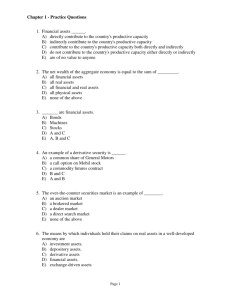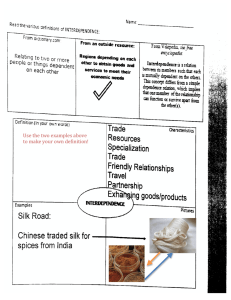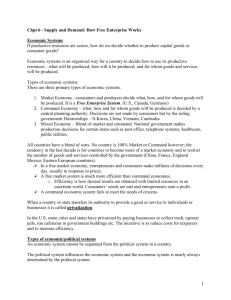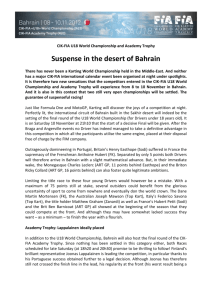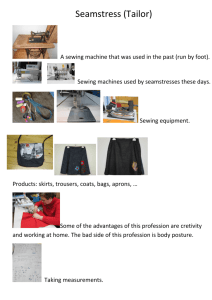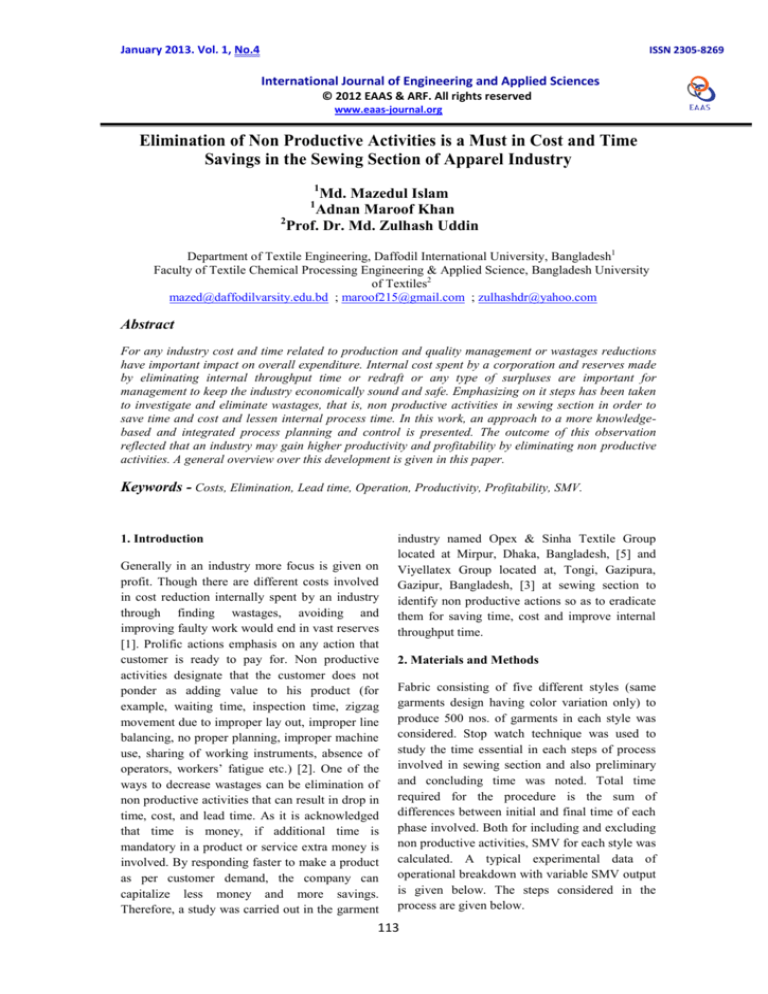
January 2013. Vol. 1, No.4
ISSN 2305-8269
International Journal of Engineering and Applied Sciences
© 2012 EAAS & ARF. All rights reserved
www.eaas-journal.org
Elimination of Non Productive Activities is a Must in Cost and Time
Savings in the Sewing Section of Apparel Industry
1
Md. Mazedul Islam
Adnan Maroof Khan
2
Prof. Dr. Md. Zulhash Uddin
1
Department of Textile Engineering, Daffodil International University, Bangladesh1
Faculty of Textile Chemical Processing Engineering & Applied Science, Bangladesh University
of Textiles2
mazed@daffodilvarsity.edu.bd ; maroof215@gmail.com ; zulhashdr@yahoo.com
Abstract
For any industry cost and time related to production and quality management or wastages reductions
have important impact on overall expenditure. Internal cost spent by a corporation and reserves made
by eliminating internal throughput time or redraft or any type of surpluses are important for
management to keep the industry economically sound and safe. Emphasizing on it steps has been taken
to investigate and eliminate wastages, that is, non productive activities in sewing section in order to
save time and cost and lessen internal process time. In this work, an approach to a more knowledgebased and integrated process planning and control is presented. The outcome of this observation
reflected that an industry may gain higher productivity and profitability by eliminating non productive
activities. A general overview over this development is given in this paper.
Keywords - Costs, Elimination, Lead time, Operation, Productivity, Profitability, SMV.
1. Introduction
Generally in an industry more focus is given on
profit. Though there are different costs involved
in cost reduction internally spent by an industry
through finding wastages, avoiding and
improving faulty work would end in vast reserves
[1]. Prolific actions emphasis on any action that
customer is ready to pay for. Non productive
activities designate that the customer does not
ponder as adding value to his product (for
example, waiting time, inspection time, zigzag
movement due to improper lay out, improper line
balancing, no proper planning, improper machine
use, sharing of working instruments, absence of
operators, workers’ fatigue etc.) [2]. One of the
ways to decrease wastages can be elimination of
non productive activities that can result in drop in
time, cost, and lead time. As it is acknowledged
that time is money, if additional time is
mandatory in a product or service extra money is
involved. By responding faster to make a product
as per customer demand, the company can
capitalize less money and more savings.
Therefore, a study was carried out in the garment
industry named Opex & Sinha Textile Group
located at Mirpur, Dhaka, Bangladesh, [5] and
Viyellatex Group located at, Tongi, Gazipura,
Gazipur, Bangladesh, [3] at sewing section to
identify non productive actions so as to eradicate
them for saving time, cost and improve internal
throughput time.
2. Materials and Methods
Fabric consisting of five different styles (same
garments design having color variation only) to
produce 500 nos. of garments in each style was
considered. Stop watch technique was used to
study the time essential in each steps of process
involved in sewing section and also preliminary
and concluding time was noted. Total time
required for the procedure is the sum of
differences between initial and final time of each
phase involved. Both for including and excluding
non productive activities, SMV for each style was
calculated. A typical experimental data of
operational breakdown with variable SMV output
is given below. The steps considered in the
process are given below.
113
January 2013. Vol. 1, No.4
ISSN 2305-8269
International Journal of Engineering and Applied Sciences
© 2012 EAAS & ARF. All rights reserved
www.eaas-journal.org
Fig.1 General overview of the garments sewing section of Viyellatex Group
Fig. 2 Front & back view of long sleeve t-shirt (men’s wear)
114
January 2013. Vol. 1, No.4
ISSN 2305-8269
International Journal of Engineering and Applied Sciences
© 2012 EAAS & ARF. All rights reserved
www.eaas-journal.org
Table 1: Experimental Garments Sewing Operational Breakdown and SMV Variation for Including & Excluding
GENERAL PRODUCT SPECIFICATION
BUYER
G-STAR
STYLE NO #
84301
ITEM
FABRIC QUALITY
GSM
WASH TYPE
LS T-SHIRT
1X1 RIB,100% COTTON
200
NORMAL WASH
FACTORY
QUANTITY
TARGET SMV
TARGET/HR
VIYELLA TEX
20, 000
17.75
83 PCS
Non Productive (NP) Activities
Sl. No
Operational Breakdown
SMV including
NP Activities
SMV excluding
NP Activities
No of
operator
M/c
1
2
3
4
5
6
7
8
9
10
11
12
13
14
15
16
17
18
19
20
21
22
23
24
25
26
27
28
29
30
31
32
33
34
Total
In side yoke iron
Position mark + yoke match
Yoke join with back part + top stitch
Main label+ loop position mark
Main label mark +joint +loop joint
Front + back part match
Shoulder joining
Shoulder top+ shoulder cut mark
Care label make +join
Neck binding + cut
Neck binding in tack
Neck 1-16top after binding
Neck binding finished top
Quality check for (1-13) operations
Laid on panel iron
Laid on panel mark
Shoulder laid on panel join
Shoulder panel top stitch
Sleeve panel match
Sleeve panel join
Sleeve panel top +sleeve pair
Sleeve & body match
Sleeve tack at armhole
Sleeve join +body turn
Quality check for (15-24) operation
Arm hole zigzag top stitch+ side top
Sleeve opening tack
Side seam join
Bottom hem tack +body turn
Bottom hem +edge cut
Patch label join +position mark
Top stitch security tack+ thread cut
Sleeve 1-4 tack + thread cut
Overall sewing quality check
0.616
0.622
1.211
0.301
0.654
0.358
0.276
0.611
0.437
0.499
0.195
0.256
0.207
0.950
0.580
0.591
0.758
0.580
0.452
0.908
0.630
0.431
0.655
0.862
0.850
0.954
0.375
0.851
0.471
0.622
0.722
0.513
0.662
2.200
18.86 min
0.556
0.510
1.110
0.258
0.580
0.328
0.250
0.532
0.410
0.452
0.180
0.250
0.195
0.750
0.520
0.556
0.510
1.10
0.258
0.580
0.328
0.250
0.530
0.410
0.655
0.440
0.180
0.250
0.195
0.520
0.440
0.652
0.551
1.450
16.60 min
2
2
2
1
1
1
1
2
1
1
1
1
1
1
1
1
1
1
1
2
1
1
1
1
1
2
1
1
1
1
1
1
1
2
41
M
M
LS
M
LS
M
OL
FL
LS
FL
LS
LS
FL
M
M
M
LS
LS
M
OL
FL
M
LS
OL
M
FL
LS
OL
LS
FL
LS
LS
LS
M
115
January 2013. Vol. 1, No.4
ISSN 2305-8269
International Journal of Engineering and Applied Sciences
© 2012 EAAS & ARF. All rights reserved
www.eaas-journal.org
2.1 Calculation of SAM or SMV through Time
Study
Step 1: Select one operation for which you want
to calculate SAM.
Step 2: Take one stop watch. Stand by side of the
operator. Capture cycle time for that operation.
(cycle time – total time taken to do all works
needed to complete one operation, i.e. time from
pick up part of first piece to next pick up of the
next
piece)
[9,
13]
Do time
study for consecutive five cycles. Discard if
found abnormal or non value added time in any
cycle. Calculate average of the 5 cycles. Time
you got from time study is called cycle time 13].
Convert this cycle time into basic time by
multiplying cycle time with operator performance
rating. [Basic Time = Cycle Time X performance
Rating]
Step 3: Performance rating. Now you have to rate
the operator at what performance level he was
doing the job seeing his movement and work
speed. Suppose that operator performance rating
is 80%. Suppose cycle time is 0.59 minutes. Basic
time = (0.59 X 80%) = 0.472 minutes
Step 4: Standard allowed minutes (SAM) =
(Basic minute + Bundle allowances + machine
and personal allowances). Add bundle allowances
(10%) and machine and personal allowances
(20%) to basic time [13]. Now you got Standard
Minute value (SMV) or SAM. SAM=
(0.472+0.0472 +0.0944) = 0.616 minutes.
Similarly, for all the operation related to the
above garments style standard allowed minute or
SAM was calculated. The approximate value of
SAM both for excluding and including non
productive time are 18.86 min & 16.60 min
respectively. Productive and non productive
activities in each steps wherever found was
identified for the above process for each style and
the SMV or SAM in minutes were noted. Finally
the ultimate SMV variation was calculated [13].
3. Results & discussion
Table 2 shows the total SMV taken for each
garment to complete the process of operation and
the same table shows SMV segregation of
productive and non productive activities.
Table 2. Variations of SMV for Non Productive (NP) Activities in Sewing Section for Different Styles.
Style No.
84301
84302
84303
84304
80205
SMV (min) including
NP Activities (A)
18.86
17.50
18.75
19.50
16.60
SMV (min) excluding
NP Activities (B)
16.60
14.70
17.25
17.60
14.30
Variation of SMV due to non productive
activities (A-B) = (C)
2.26
2.80
1.50
1.90
2.30
25
20
15
SMV including NP activities
SMV excluding NP activities
Variation in SMV
10
5
0
Style#
84301
Style#
84302
Style#
84303
Style#
84304
Style#
84305
116
January 2013. Vol. 1, No.4
ISSN 2305-8269
International Journal of Engineering and Applied Sciences
© 2012 EAAS & ARF. All rights reserved
www.eaas-journal.org
Fig. 3 Style-wise SMV variations due to productive & non productive activities
These non productive time are due to waiting,
inattention of operators, no proper identification,
zigzag movement due to inappropriate lay out, no
proper planning, improper machine use, sharing
of working instruments, absence of operators,
workers’ fatigue, less experienced workers, poor
machine performance, no standard operation
followed by operator, Machine break down,
imbalanced line (WIP control), continuous
feeding to the line, quality problem, individual
operator
performance
level,
operators
absenteeism, etc [11, 15].
Below table 3 shows the style-wise costs of
productive and non productive activities in
sewing section. As per the factory information,
the unit CM costs for each garments in sewing
section was taken into consideration to calculate
the overall productive and non productive
activities cost in terms of SMV, CM & production
rate and consequent cost savings in ultimate
factory expenditure. During the experimental
observation, total productive and non productive
times were identified separately and costs related
to each time also calculated. Finally, cost savings
for non productive activities time in terms of total
time (both for including and excluding non
productive time) required to finish the job were
calculated.
3.1 Formula for production estimation
Daily production = Total man minutes available
in a day/SAM X Average Line efficiency
Total available man-minutes =Total no. of
operators X Working hours in a day X 60%, [13]
Suppose, SAM of the garment is 18.86 minutes, a
line of 41 operators, works at 8 hours shift / day.
Line works at average 60% efficiency.
So, Total available man minutes = 41 X (8 X 60)
= 19680 minutes
Daily estimated production = 19680 /18.86 X
60% = 626 pieces/day (For SMV 18.86 min.)
So, per hour production = 626/8 = 78 pieces/hour
Again, daily estimated production = 19680 /16.60
X 60% = 712 pieces/day (For SMV 16.60 min.)
So, per hour production = 712/8 = 89 pieces/hour
From the above calculation it is easily observed
that due to SMV variation for including and
excluding NP activities, variation in daily
estimated production is (712-626) = 86 pieces.
And variation in hourly production is (89-78) =
11 pieces approximately.
Table 3: Style-Wise Production Rate Variation at Variable SMV
Style
No.
84301
84302
84303
84304
80205
Total
Avg
SMV (min)
including NP
Activities (A)
18.86
17.50
18.75
19.50
16.60
91.21
18.24
Output/hour at SMV
(min) Output/hour Variation in
60% efficiency excluding NP at
60% SMV (A-B)
Activities (B) efficiency
= (C)
78
16.60
89
2.26
84
14.70
101
2.80
79
17.25
86
1.50
76
17.60
84
1.90
89
14.30
104
2.30
406
80.45
464
10.76
81
16.09
93
2.15
In Viyellatex Group per day (8 hr shift) average
CM cost for the above experimental style is
considered as $21.60 per dozen or $1.8 per piece.
From the table 3, it is clearly observed that due to
SMV variation for including and excluding non
productive activities the sum of SMV is 10.76
Variation in
output/hour
(D)
11
17
07
08
15
58
12
min for which estimated production variation is
58 pieces per hour for the above five styles in
five production line. The table also indicates that
due to non productive activities about 2.15 min
extra SMV is required on average for which
equivalent production loss per hour is
117
January 2013. Vol. 1, No.4
ISSN 2305-8269
International Journal of Engineering and Applied Sciences
© 2012 EAAS & ARF. All rights reserved
www.eaas-journal.org
approximately 58 pieces. So, we can calculate the
average production loss in terms of total factory
economy that is the way of costs savings for the
industry.
The average variation in production/hour / line is
12 pieces
given as one common book is used, proper
quality checking, minimum waiting time,
inspection time, reduced zigzag movement etc.
These recommendations were suggested to the
sewing section.
The average factory earning loss or cost savings /
hour/line is $1.80 x 12 = $21.6
The average variation in production / day / line is
12 x 8 = 96 pieces
5. Conclusion
The average factory earning loss or cost savings /
day / line is $1.80 x 12 x 8 = $172.8
The suggestive tools developed in this article
cover a comprehensive series of aspects in
minimizing cost and time in the sewing section
of apparel industries by ensuring quality
production. It was observed that time was saved
and cost related to time was utilized properly
(reduced by eliminating non productive
activities).The study clearly indicates that by
eliminating non productive activities in the
sewing section time as well as cost are saved
which have an important impact on overall
factory economy. This paper also will aid
industry in the development of apparel
production quality and production rate by
minimizing non productive activities.
The average variation in production/month / line
is 12 x 8 x 26 = 2496 pieces
The average factory earning loss or cost savings /
month / line is $1.80 x 12 x 8 x 26 = $4492.8
The average variation in production / year / line
is 12 x 8 x 26 x 12 = 29952 pieces
The average factory earning loss or cost savings /
year / line is $1.80 x 12 x 8 x 26 x 12 = $53913.6
Similarly, if this figure is considered in terms of
total factory economy then a huge amount of
factory earning loss could be saved easily that
may have an important impact on overall factory
economy. For example, from the above
experimental data analysis we can estimate the
earning figures for any factory as big as
Viyellatex Group having 80 production lines that
may save $4313088/year (80 lines x $53913.6).
Earning loss $4313088/year, what a big amount
they are losing!
References
[1] Feld,M.W.,(2000).Lean
Manufacturing:
Tools, Techniques, and how to use them.
Boca Raton, London: The St. Lucie Press
[2] Kumar, S. A. (2008). Production and
Operations Management. Daryaganj, Delhi,
India: New Age International, p. 217-220.
[3] (viyellatex group)(n.d.). Retrieved december
2012,
from
viyellatex
group:
http//www.viyellatexgroup.com
[4] Shahidul, M. I. and Syed Shazali, S. T.
Dynamics of manufacturing Productivity:
Journal of Manufacturing Technology
Management Vol. 22 No. 5, 2011, p. 664678
[5] (Opex Group) (n.d.). Retrieved december
2012,
from
viyellatex
group:
http//www.opexgroup.com
[6] Productivity Development Team, ed.
Cellular Manufacturing: (Portland, .Oregon:
Productivity Press, 1999).
[7] (Sepal Group)(n.d.). Retrieved december
2012.
From
sepal
group
http//www.sepalgroup.com
[8] (n.d.). Retrieved nov 2012, from Clothing
Study:http//www.online/clothingstudy.com
[9] (n.d.). Retrieved dec 2012, from MBM
Garments: http//www.mbmgarments.com
[10] (n.d.). Retrieved nov 2012, from fiber 2
fashion: http//www.fiber2fashion.com
4. Recommendations to reduce non productive
activities
Some of the recommendations provided to
reduce non productive activities time are,[14, 16]
proper production planning, effective application
of industrial engineering, well trained operator,
proper layout plan, minimum rework, smooth
running of sewing
machine, proper line
balancing, right time oiling to the sewing
machineries, ensuring quality production,
sufficient numbers of working aids can be
provided for smooth working, stickers can be
used for identification, manual counting is not
required, correct shade variation, length, width of
the fabric should be issued by proper
identification, proper allocation of manpower is
necessary, books to note down production to be
118
January 2013. Vol. 1, No.4
ISSN 2305-8269
International Journal of Engineering and Applied Sciences
© 2012 EAAS & ARF. All rights reserved
www.eaas-journal.org
[11] [Saroj Bala, Factors Influencing Costing of
Woven Fabrics, The Indian Textile Journal,
June 2003
[12] Dr P Khanna: Work study, time and motion
study, Dhanpat Rai and Sons, New Delhi,
(pp 21).
[13] Pojasek, Robert B. “Five S: A Tool That
Prepares an Organization for Change.”
Environmental
Quality
Management
(Autumn 1999) 97-103.
[14] Productivity Development Team, Just-inTime for Operators (Portland, Oregon
Productivity Press, 1998)
[15] Romm, Joseph J.
Lean and Clean
Management: How to Boost Profits and
Productivity by Reducing. Pollution (New
York: Kodansha International, 1994)
119

